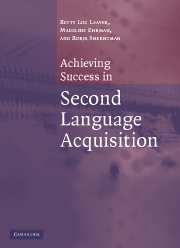Book contents
- Frontmatter
- Contents
- Notes on authors
- Acknowledgments
- Note to the reader
- Part I Learning
- Part II Language
- Part III Independence
- Epilogue: from here to there: attaining near-native proficiency
- Appendix A Answers to “practicing what you have learned”
- Appendix B Learning strategies taxonomies
- References
- Index
Epilogue: from here to there: attaining near-native proficiency
Published online by Cambridge University Press: 12 November 2009
- Frontmatter
- Contents
- Notes on authors
- Acknowledgments
- Note to the reader
- Part I Learning
- Part II Language
- Part III Independence
- Epilogue: from here to there: attaining near-native proficiency
- Appendix A Answers to “practicing what you have learned”
- Appendix B Learning strategies taxonomies
- References
- Index
Summary
You may be taking a language for university requirements or general casual interest. Perhaps you do not plan a career based on language skill. In that case, this epilogue is not for you.
If, however, you do plan a career in which you will need to use foreign language professionally or wish to become very, very proficient in the language you are learning, you should be aware that the level of language proficiency attained in a typical university foreign-language program is insufficient for professional use of the foreign language. You will need to develop a lifelong-learning approach to foreign-language acquisition to acquire professional and advanced professional (near-native) levels of foreign language proficiency. To date, there is not a lot known about how to do this. Among the authors of this book are those who have achieved near-native proficiency in one or more languages, those who have taught or supervised foreign-language programs for highly advanced students, and those who have conducted research on the attributes of high-level proficiency and what it takes to reach it. This chapter, then, reports on what we do know to date from personal experience in learning and teaching at high levels and in early research results from surveys of individuals who have reached these levels.
Attributes and experiences of successful high-level learners
You may have heard a lot about what a good language learner is. You may have been told that one learning style or another is better.
- Type
- Chapter
- Information
- Achieving Success in Second Language Acquisition , pp. 234 - 243Publisher: Cambridge University PressPrint publication year: 2005



